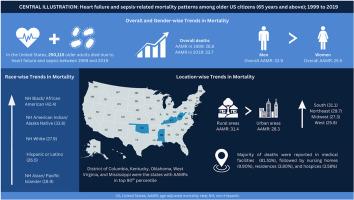探讨美国老年心力衰竭和败血症患者死亡率的上升:医疗保健政策改革的必要性
IF 2.1
Q3 PERIPHERAL VASCULAR DISEASE
International Journal of Cardiology Cardiovascular Risk and Prevention
Pub Date : 2025-05-11
DOI:10.1016/j.ijcrp.2025.200428
引用次数: 0
摘要
心衰(HF)患者通常是多种疾病和免疫功能低下的患者,特别容易感染败血症,这增加了他们的死亡风险。因此,了解老年人(≥65岁)合并心衰和败血症的死亡率模式对于改善美国的护理策略至关重要。方法对来自疾病控制与预防中心广泛的流行病学研究在线数据(CDC WONDER)的死亡证明进行横断面评估,以检查HF和败血症的死亡率趋势。对于人口统计学和地理亚组,导出了每100,000名老年人的年龄调整死亡率(AAMR),以及AAMR的年百分比变化(APC),置信区间为95% (CI)。从1999年到2019年,在老年人中记录了250,115例与HF和败血症相关的死亡,其中大多数是在医疗机构报告的。总体AAMR从1999年的28.8上升到2019年的33.7。男性(33.9)比女性(25.5)更明显。非西班牙裔(NH)黑人/非洲裔美国人的aamr最高(42.4)。与此同时,NH亚洲/太平洋岛民报告的最低(18.9)。非都市地区(31.4)和南方地区(31.1)的aamr较高。州际差异显示,aamr最高的是密西西比州(45.4),最低的是亚利桑那州(12.1)。结论HF和败血症的死亡率在过去20年中有所增加,其中NH黑人/非洲人的增幅最大。未来的研究应该调查这种增长背后的机制,特别关注导致差异的因素,为弱势群体制定有针对性的干预措施。本文章由计算机程序翻译,如有差异,请以英文原文为准。

Exploring the rising death rates among older US citizens with heart failure and sepsis: Need for health-care policy reform
Background
Heart failure (HF) patients, often multimorbid and immunocompromised, are particularly vulnerable to sepsis, which increases their risk for mortality. It is therefore crucial to understand the mortality patterns in older adults (≥65) with HF and sepsis for improving care strategies in the United States.
Methods
A cross-sectional evaluation of death certificates from the Centers for Disease Control and Prevention's Wide-Ranging Online Data for Epidemiologic Research (CDC WONDER) was conducted to examine HF and sepsis mortality trends. For demographic and geographic subgroups, age-adjusted mortality rates (AAMR) per 100,000 older individuals, alongside annual percent change (APC) in AAMR with 95 % confidence intervals (CI), were derived.
Results
Throughout 1999 to 2019, 250,115 deaths associated with HF and sepsis were recorded among older adults, the majority being reported in medical facilities. The overall AAMR escalated from 28.8 in 1999 to 33.7 in 2019. AAMRs were more pronounced in men (33.9) than in women (25.5). Non-Hispanic (NH) Black/African American individuals exhibited the highest AAMRs (42.4). At the same time, NH Asian/Pacific Islanders reported the lowest (18.9). AAMRs were higher in non-metropolitan areas (31.4) and the Southern region (31.1). State-level disparities revealed the highest AAMRs in Mississippi (45.4) and the lowest in Arizona (12.1).
Conclusion
Mortality from HF and sepsis has increased over the last 20 years, with NH Black/African individuals demonstrating the greatest increases. Future studies should investigate the mechanisms underlying this increase, particularly focusing on the factors that drive disparities, to develop targeted interventions for vulnerable groups.
求助全文
通过发布文献求助,成功后即可免费获取论文全文。
去求助
来源期刊

International Journal of Cardiology Cardiovascular Risk and Prevention
Cardiology and Cardiovascular Medicine
CiteScore
3.00
自引率
0.00%
发文量
0
审稿时长
72 days
 求助内容:
求助内容: 应助结果提醒方式:
应助结果提醒方式:


